Scientific name Myllokunmingia fengjiaoa | Phylum Chordata Species M. fengjiaoa Rank Genus | |
Similar Haikouichthys, Haikouella, Yunnanozoon, Pikaia, Metaspriggina | ||
Pl1 fossil jawless fish myllokunmingia
Myllokunmingia is a genus of basal chordate from the Lower Cambrian Maotianshan shales of China, thought to be a vertebrate, although this is not conclusively proven. It is 28 mm long and 6 mm high.
It is among the oldest possible craniates, found in the lower Cambrian Chengjiang (520 million years ago). It appears to have a skull and skeletal structures made of cartilage. There is no sign of biomineralization of the skeletal elements.

The holotype was found in the Yuanshan member of the Qiongzhusi Formation in the Eoredlichia Zone near Haikou at Ercaicun, Kunming City, Yunnan, China. The animal has a distinct head and trunk with a forward sail-like (1.5 mm) dorsal fin and a ventral finfold (probably paired) further back. The head has five or six gill pouches with hemibranchs. In the trunk there are 25 segments (myomeres) with rearward-facing chevrons. There is a notochord, a pharynx and a digestive tract that may run all the way to the rear tip of the animal. The mouth cannot be clearly identified. There may be a pericardial cavity. There are no fin radials.

There is only one specimen, which has the tip of the tail buried in sediment. Only one species is known – Myllokunmingia fengjiaoa (Shu, Zhang & Han).

Related creatures are Haikouichthys and Zhongjianichthys.

